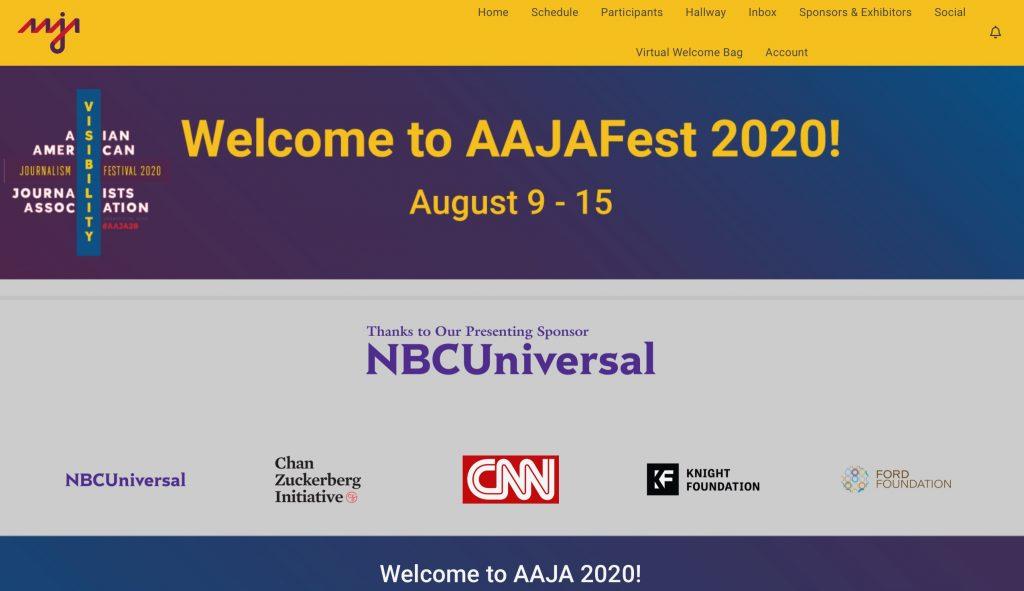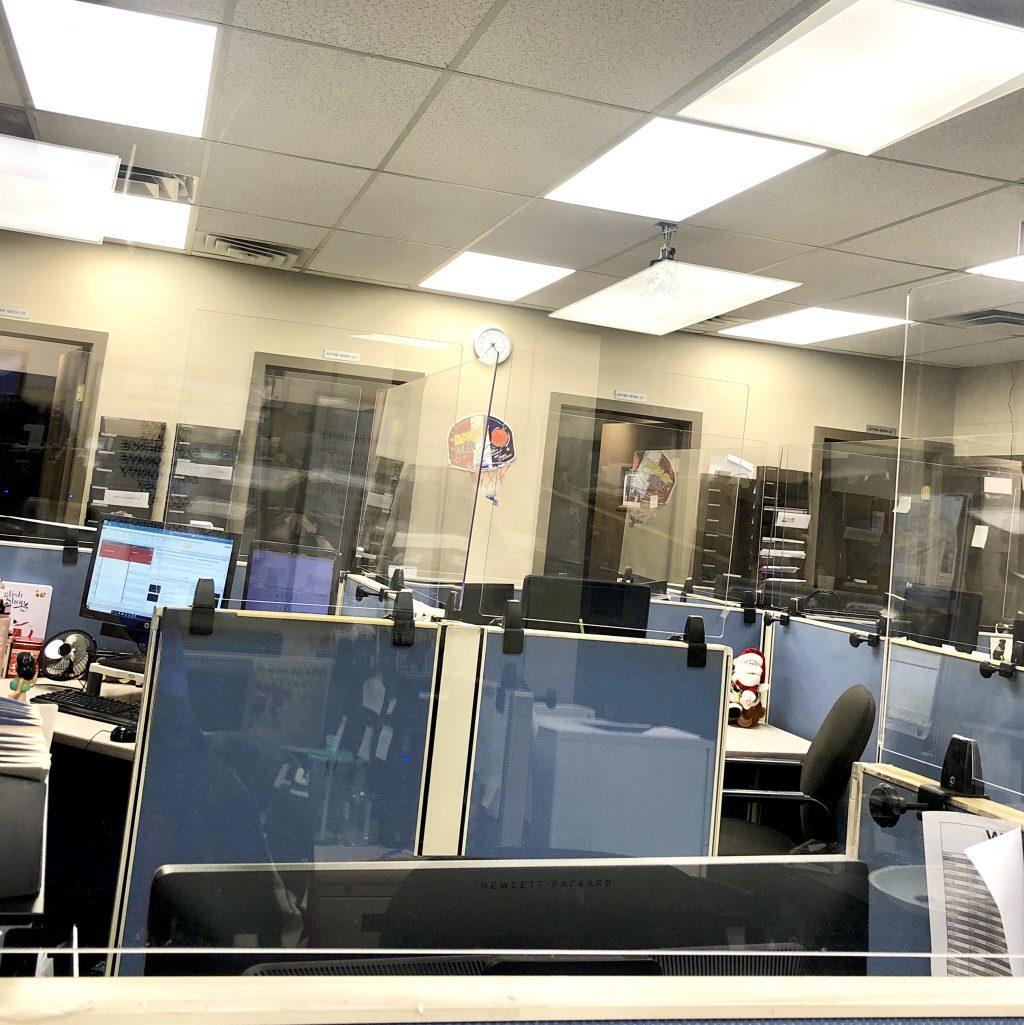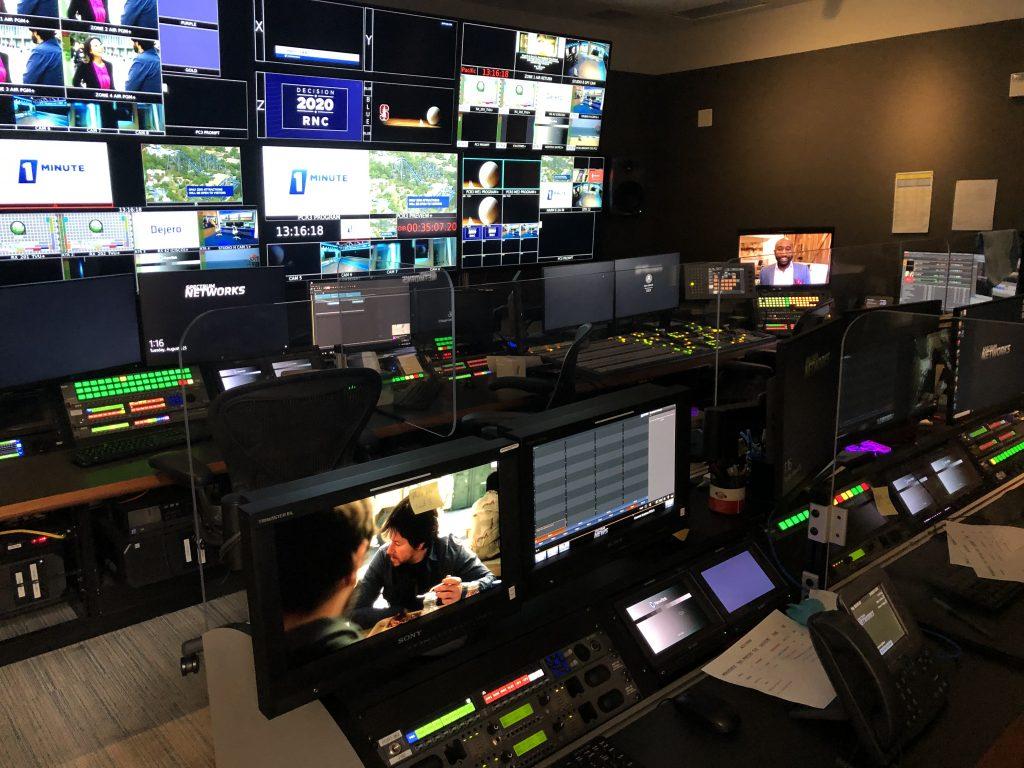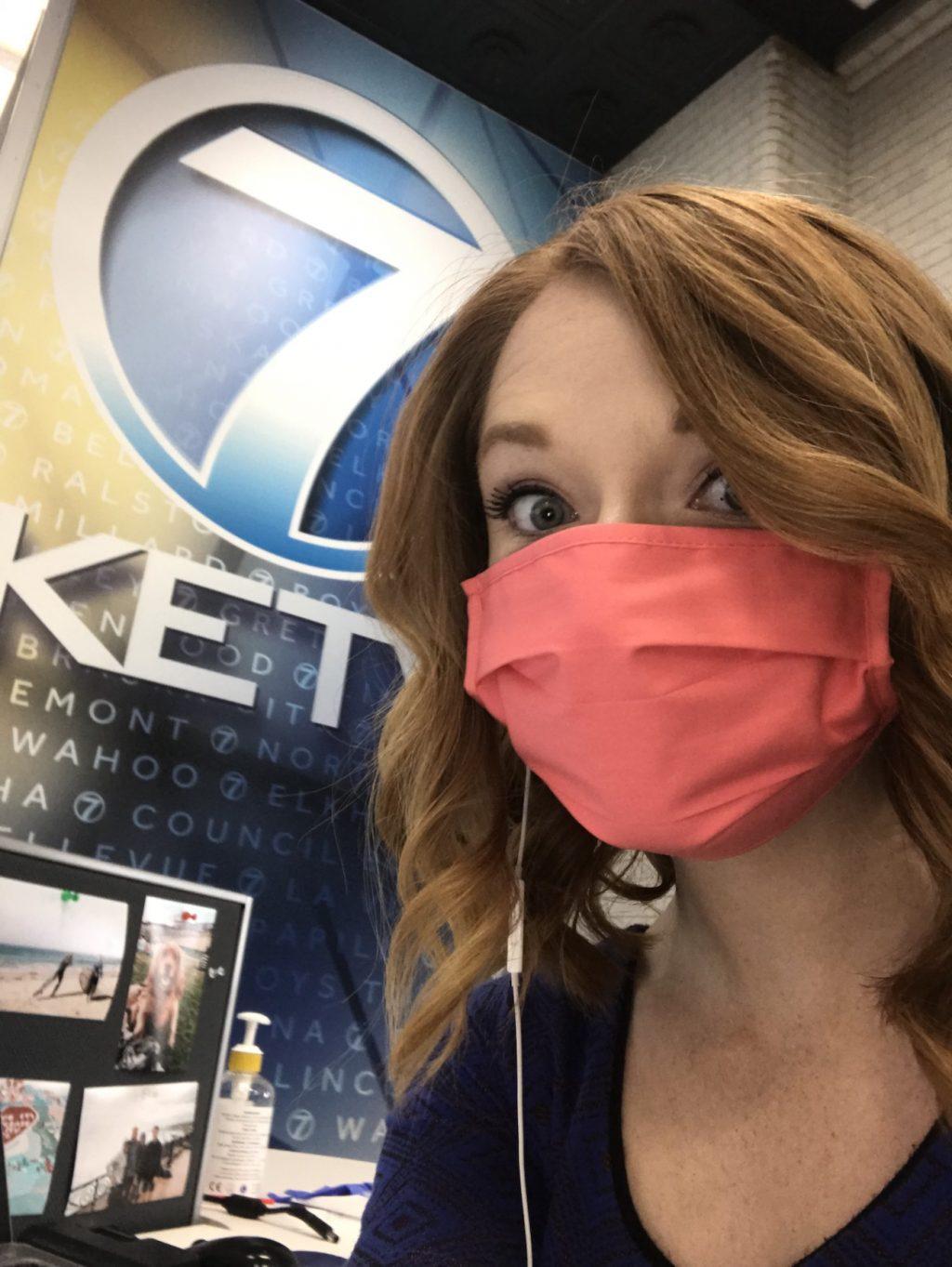Pepperdine alumna Emily Tencer interviews an individual outside a bar in Nebraska while practicing social distancing and wearing a mask. Due to the COVID-19 pandemic, journalists have had to adjust to staying safe while also continuing to cover news. Photo courtesy of Emily Tencer
Amid a crowd of more than a hundred demonstrators protesting in Omaha, Nebraska, on Aug. 24 in retaliation for the police shooting of Jacob Blake in Kenosha, Wisconsin, Pepperdine alumna Emily Tencer (2019), a reporter at KETV NewsWatch 7, reports the breaking news as it unfolds.
“When you’re in that moment, and when you’re covering news, you have your mask on, you have your gloves on, but you’re covering the story,” Tencer said. “And so you have to stay as safe as possible but also focus on the moment that you’re in.”
As alumni work to stay safe and cover their communities during the COVID-19 pandemic, aspiring journalists from Pepperdine’s class of 2020 are entering the journalism industry.
Class of 2020 Journalists
Alumna Channa Steinmetz (2020) recently found a job near the end of July as an innovation journalist at Startland News in Kansas City, Missouri. She said feels lucky she got the job.
Steinmetz served as the executive editor of the Graphic in the spring and said this experience helped her navigate the job market after graduation.
“The Graphic has taught me to really work on my feet and be adaptable because we had so much breaking news happen in the past few years while I was working there,” Steinmetz said. “And that is the number one thing with journalism; I think you need to be ready for the unexpected, and the job market was definitely unexpected.”
Another alumna, Madeleine Carr (2020), who was the previous managing editor of the Graphic, has also been looking for jobs over the summer.
Carr had considered attending graduate school and going into the publishing industry; however, she said she decided to job hunt in Hawaiʻi, where her home and family are, and hold off on her earlier plans since she wanted to go to school in person.
She said she is now applying for jobs involved with communication and media relations.
“These jobs would be really, really exciting and conducive because they would allow me to explore different elements of journalism — different elements of media relations that I hadn’t necessarily delved super deep into before,” Carr said.
Alumna Kayiu Wong (2020), who served as the digital editor at the Graphic, said she hopes to work an entry-level job at a network and has been actively applying for those opportunities.

After graduation, Wong went back to her home in California, and she said one of the challenges she faced was feeling guilty for not using her free time to do something productive.
“I felt like that was something that always came up — this guilt I had that I wasn’t doing enough,” Wong said. “Emotionally, I feel like that was definitely the hardest part of the job hunt during this weird time.”
The Journalism Industry
In mid-August, Wong attended the Asian American Journalist Association virtual conference and said she found it encouraging.

“It was a huge week of just community, clarity, professional development — everything I needed since graduating, so it was really great,” Wong said.
Wong said being around other journalists, even virtually, is empowering and motivating. Various topics discussed at the conference included rising hate crimes against Asian Americans during the pandemic, the national reckoning of race across the country and in newsrooms and the state of the journalism industry amid the pandemic.
“There were a lot of thoughtful conversations about the state of journalism, how to report on minority communities and how to stand up for journalists of color in newsrooms, which are, obviously, all really meaningful and necessary topics,” Wong said.
Another point of discussion among journalists is the increase in engagement with the news and distrust of the media.
“What is encouraging about all of this is that now more than ever, people are relying on journalists for information,” Tencer said. “With the pandemic, with protests, people are going to their news source to watch what is going on.”
Tencer and fellow alumni in the journalism industry Araceli Crescencio (2019) and Logan Hall (2018) all said they have been even more intentional about double-checking data in their respective roles — especially to make sure it’s not getting lost within the flood of information they have handled.
Crescencio is a reporter and producer at WLNS-TV in Lansing, Michigan, and alumnus Hall is a producer at Spectrum News 1 in Southern California.
“You hear all the time that journalism is a dying industry, and times like these show that it’s exactly the opposite,” Hall said. “When people need to know what’s happening, we’re there for them, and we’re dedicated to giving them the news.”
Change in Operations
Growing up in a military family and moving every two years, Tencer said she has learned to become adaptable, which prepared her for being a journalist during a pandemic. Tencer’s 10 o’clock newscast is a consistent part of her job that she has found some comfort in throughout all the other changes.
“That will not change — at the end of the day, there will always be a 10 o’clock newscast, and that is the only constant that I have,” Tencer said. “But that is what keeps me sane; as crazy how things have changed, there are constants, and that constant is still doing the work, meeting the deadline.”
Crescencio has also been on the front lines, covering rallies that supported a barber shop remaining open during Gov. Gretchen Whitmer’s stay-at-home order.
“I obviously wore my mask, but people were yelling at me, ‘Why are you wearing a mask?’” Crescencio said. “But other than that, I think for the most part, my experience has been pretty positive with my sources or my interviewees being accommodating.”
Crescencio said at WLNS, the gear for reporters changed to follow social distancing guidelines. Reporters now use a long stick mic when speaking with their interviewees to avoid putting the mics close to sources. Wiping equipment down and hand sanitizing has also become a more frequent practice.
The newsroom at WLNS has also changed, with staff restricted to certain shifts and plexiglass enveloping cubicles.

Hall said in early March, his news director told him and some of his co-workers that a previous guest on the show had tested positive for the virus and that they had to work from home. The next week, Hall produced newscasts from his couch.
“It’s tough not being in the control room when you’re live or when you’re recording your segments,” Hall said. “It’s hard not being right in your anchor’s ear or feeling like you have that sort of control over everything, but it’s been an adjustment for sure.”

Hall, Crescencio and Tencer said their day-to-day jobs have changed significantly.
“What used to be a crowded and loud environment is now half empty, and every desk is separated with plexiglass, and control rooms are sanitized between every recording — it’s a really different place,” Hall said. “It’s caused us to change the ways that we communicate with each other, in the ways we produce our shows. Every aspect of life in the newsroom is different than it was six months ago.”
As a broadcast reporter, Tencer said working from home has been especially difficult because many of the stories revolve around visuals.
“It is so hard,” Tencer said. “As a reporter, your day is just go, go, go; you are driving around town, you’re meeting so many people. For a pandemic to hit when your job is literally to interact and meet other people was very odd.”
Hall said at one point, he and his co-workers had to operate a studio for their entire morning show out of a trailer in the parking lot of their network because it was the only safe place.
“We made that happen; we put information on air,” Hall said. “We did a full show out of a box in a parking lot, and it shows the resilience that journalists have, that producers have, directors, editors. Everybody who’s a part of the team understands how important our mission is and is dedicated to doing it.”
Hall said the biggest challenge in adjusting to this time, however, has been keeping up with the flood of information and identifying the most important stories for viewers.
“What we’re focused on at our station is sort of hyper-local coverage and stories that really impact our community,” Hall said.
Omaha, Nebraska
As a general reporter, Tencer said pre-COVID-19, some of the news her station covered included city council meetings, preparation leading up to the Iowa caucus and many agriculture stories, especially with floods impacting Nebraska’s numerous farmlands.
KETV in Omaha covered pandemic-related stories before other areas because a lot of the U.S. citizens who were in Wuhan, China, when the virus first spread came to Ashland, Nebraska, to quarantine for two weeks and receive medical care, Tencer said. Then more COVID-19 evacuees from the Diamond Princess cruise ship in Japan came to the medical center in Nebraska.
“When you think of Nebraska — for most people who are not from here — they do not know what happens here, but we have an amazing medical center,” Tencer said.
Tencer said she was the first reporter at her station to do a COVID-19 story, which covered people arriving from Wuhan and quarantining in Camp Ashland.
“It’s crazy looking back at that first story because, in the moment, it really didn’t hit me that we could be affected,” Tencer said. “I was interviewing people who were in lockdown in Wuhan and now in quarantine at Camp Ashland, and it was so surreal to me. In that moment, I could not fathom that the United States would eventually be going through something similar.”
Another angle unique to Nebraska and some other Midwest states has been the COVID-19 outbreaks in meatpacking and meat-processing plants, Tencer said. These outbreaks have led to higher unemployment rates and meat shortages.
“Our South Omaha community has been hurting a ton and has been leading our cases in the city because a lot of the people who work in South Omaha work in meatpacking plants,” Tencer said.
Omaha did not have a mask mandate until early August. Tencer said it was one of the last cities to have an ordinance on masks, and it was a big deal when the city council passed it.

Lansing, Michigan
WLNS-TV started to report on COVID-19 by mid-February, and by March, it became the station’s primary focus.
Michigan had a massive protest April 15 in response to Gov. Whitmer’s “Stay Home, Stay Safe” executive order. Crescencio said Michigan has played an important political role during the pandemic because it is highly polarized.
“Throughout the whole pandemic, it’s been a big fight in terms of what gets to stay open: ‘What are the governor’s powers? Can she extend the state of emergency for so long?’” Crescencio said.
As a bilingual reporter, Crescencio has also started a new digital segment at WLNS-TV that provides local news to Spanish-speaking communities in the area. She said she worked overtime to help make sure everyone in mid-Michigan had access to the latest COVID-19 updates, and the Spanish speaking community received the segment positively.
Crescencio said some of her favorite stories have been the lighthearted feature stories that show people and businesses doing their part to help others — especially those in the front lines in health care.
With Michigan State University being one of the largest public universities in the nation, Crescencio said she also wants to understand the back-to-school angle in her local community.
“I think reporting during the pandemic has emphasized the importance of local news and just how essential the truth really is,” Crescencio said. “It’s been such a learning process to see this is going to be the biggest story we tell in our lives.”
Crescencio said she believes a topic that needs more coverage is the disproportionate effects of COVID-19 on minority populations.
“Even here in Michigan, African Americans and Latinos are more likely than other races to get the virus as well as die from the virus,” Crescencio said. “So I think that’s something […] I’ve been drawn to: trying to understand the racial gap and why it’s happening and what are the resources that are being given to prevent that.”
Covering Black Lives Matter
Coverage shifted fairly quickly from COVID-19 to Black Lives Matter protests in late May and early June. Hall said it was difficult to figure out how to make sure reporters stay safe while covering the protests; however, reporters at Spectrum News 1, among many other news stations, ultimately wanted to be at the heart of the demonstrations while taking necessary precautions.
“We told some incredible stories of people who are trying to create change in this world, and it was challenging, given the time that we’re telling these stories,” Hall said. “It’s a protest in the midst of a pandemic, but I think that in times like this, we see the best in humanity.”
In Omaha, Tencer was one of the reporters out in the streets and in the crowds covering the protests that emerged in response to the killing of George Floyd.
“As a reporter, it was so hard; for months now, we have been listening to what medical officials are saying about the virus and how to handle the virus, and then all of a sudden, I’m in a crowd,” Tencer said. “And after months of avoiding crowds and avoiding people and then just being around so many others, it was unreal.”

Advice for Future Journalists (And Anyone Else)
As a recent graduate, Wong has learned to give herself grace during these uncertain times, and she said she encourages others to do the same.
“I feel like with graduating college, the next step is to get a job, and there’s so much pressure with that,” Wong said. “Obviously, this year, that pressure has just been significantly compounded and made things feel worse, and I totally understand that because I’m in that boat — but I think knowing not to take that out on yourself or to doubt your abilities throughout this whole process is important because things are just so uncertain.”
Crescencio also advises students and those searching for a job to stay persistent and resilient; having been through the job search process recently herself, she understands the feelings some students might be experiencing.
“I was getting nervous and self-doubting whether any news organization really wanted me or whether I was good enough — and with things like that, I think the application process can be intimidating, and then everybody just seems to have their life together,” Crescencio said. “But I would tell them that they know exactly what they’re doing and to keep applying and following up with their applications.”
____________________
Follow the Graphic on Twitter: @PeppGraphic
Email Emily Shaw: emily.c.shaw@pepperdine.edu

